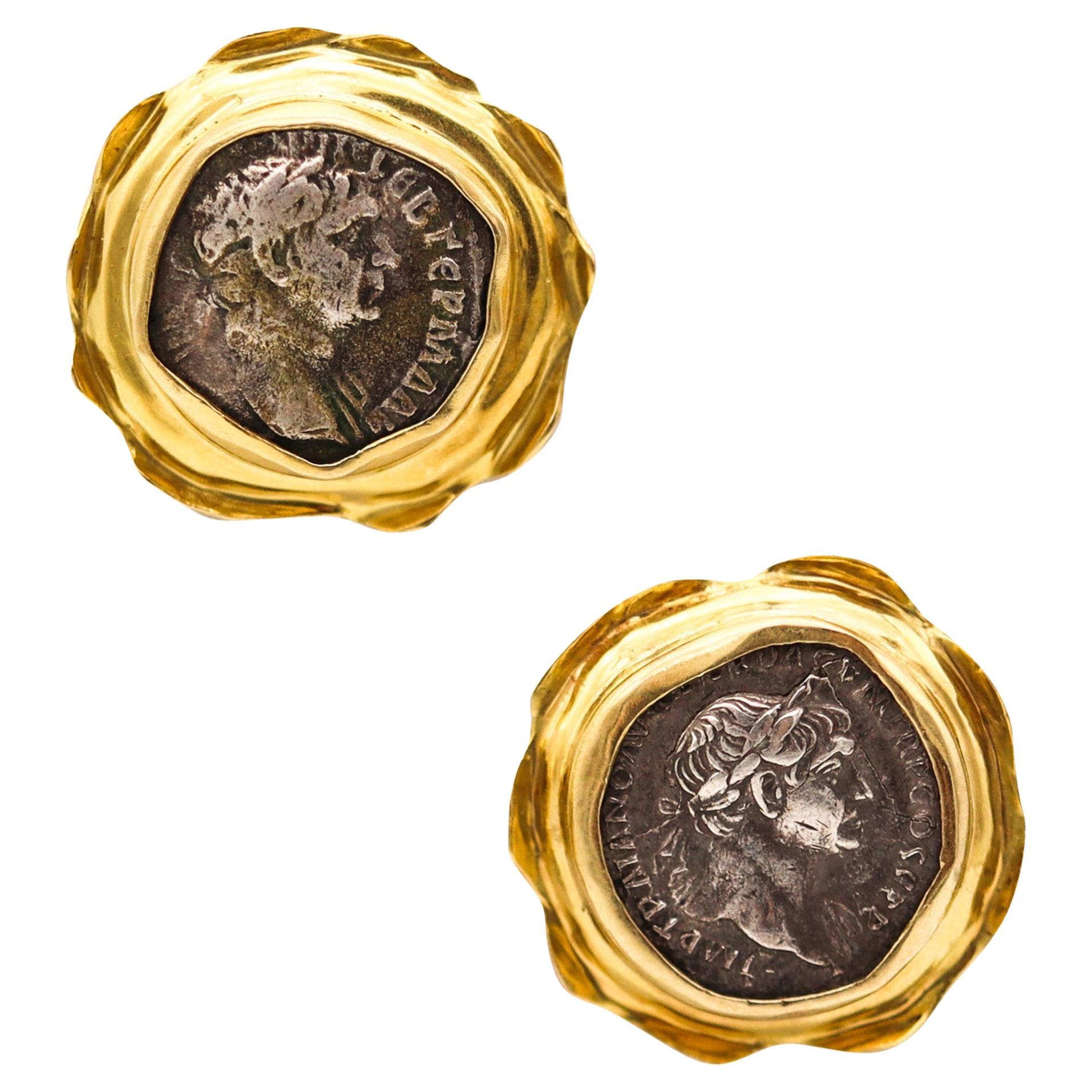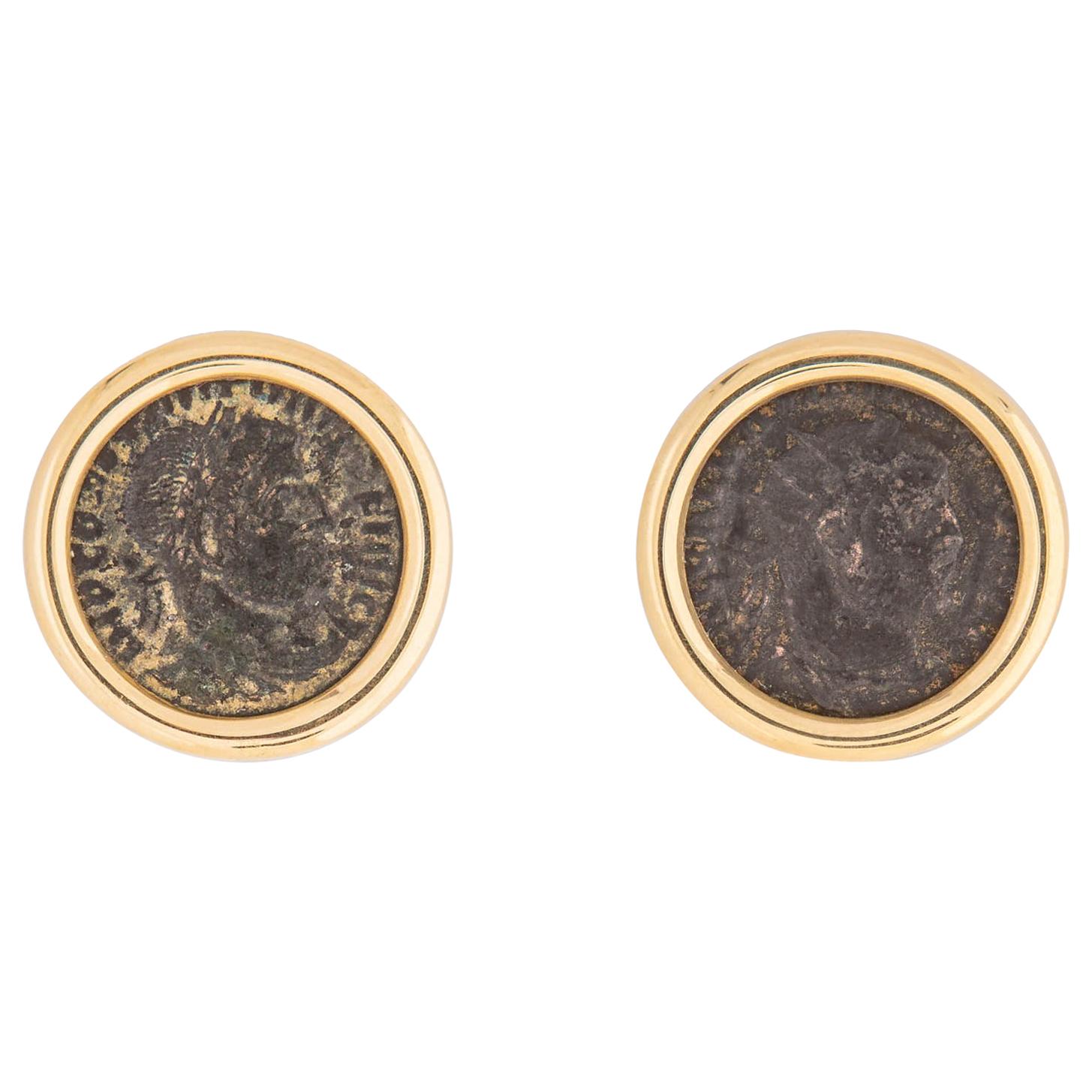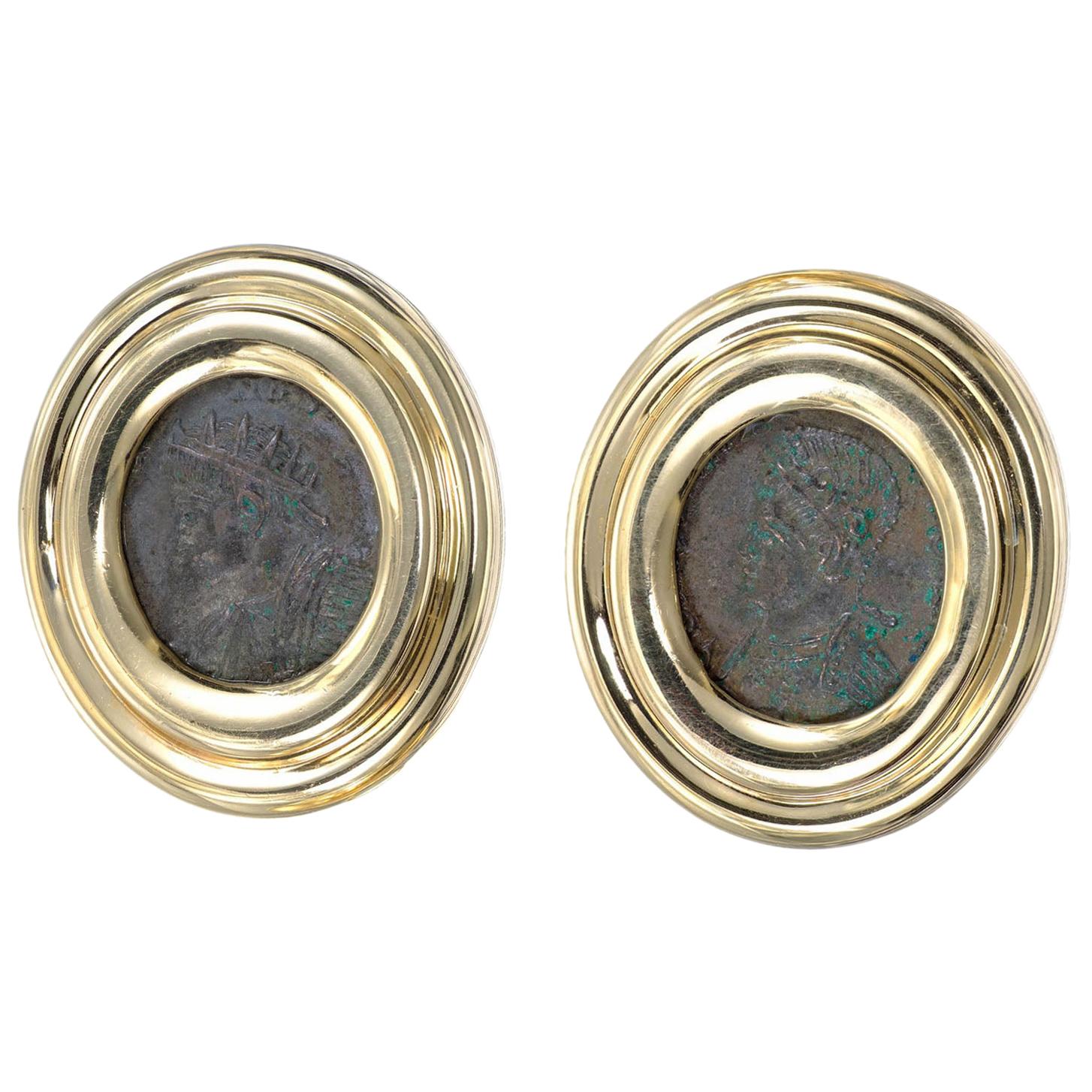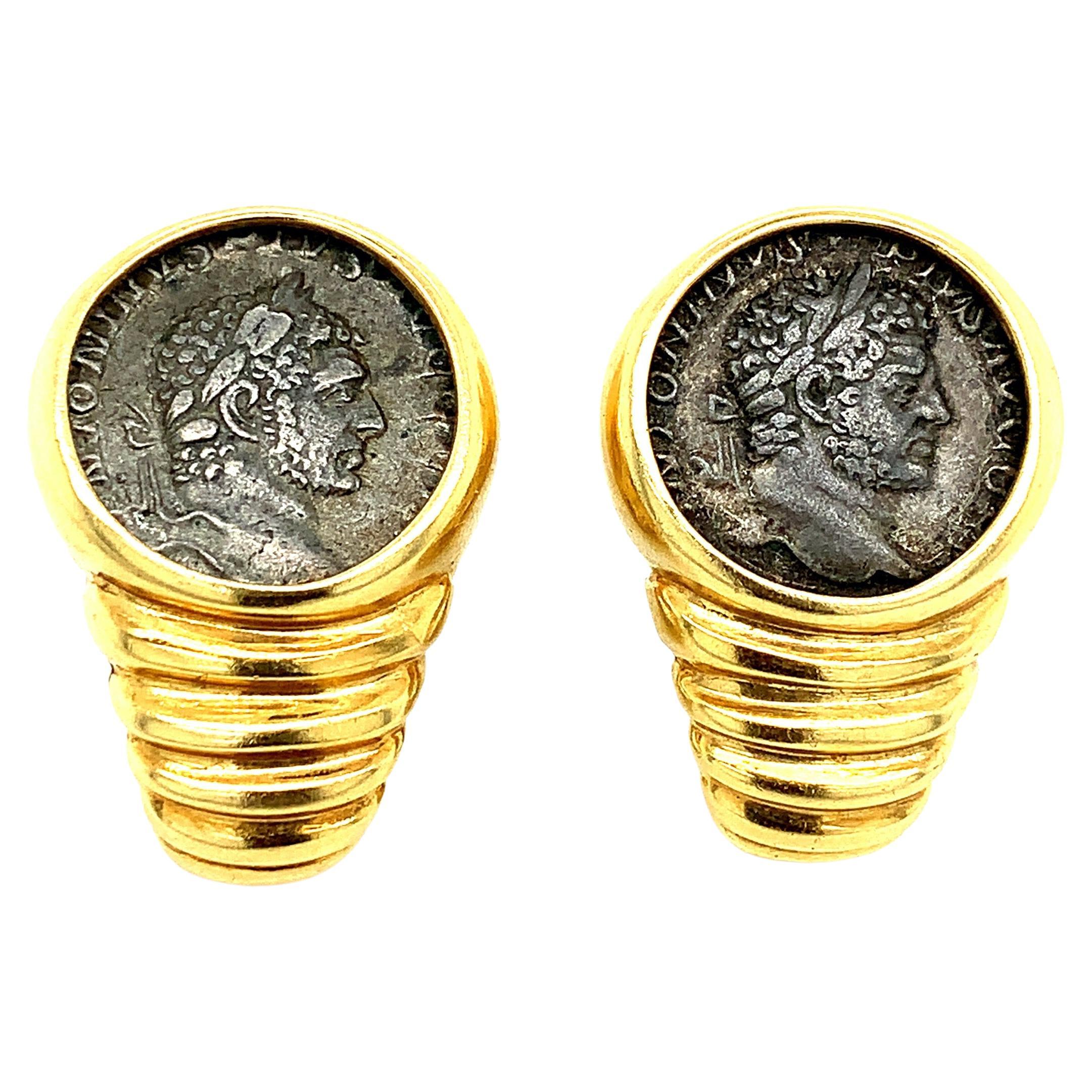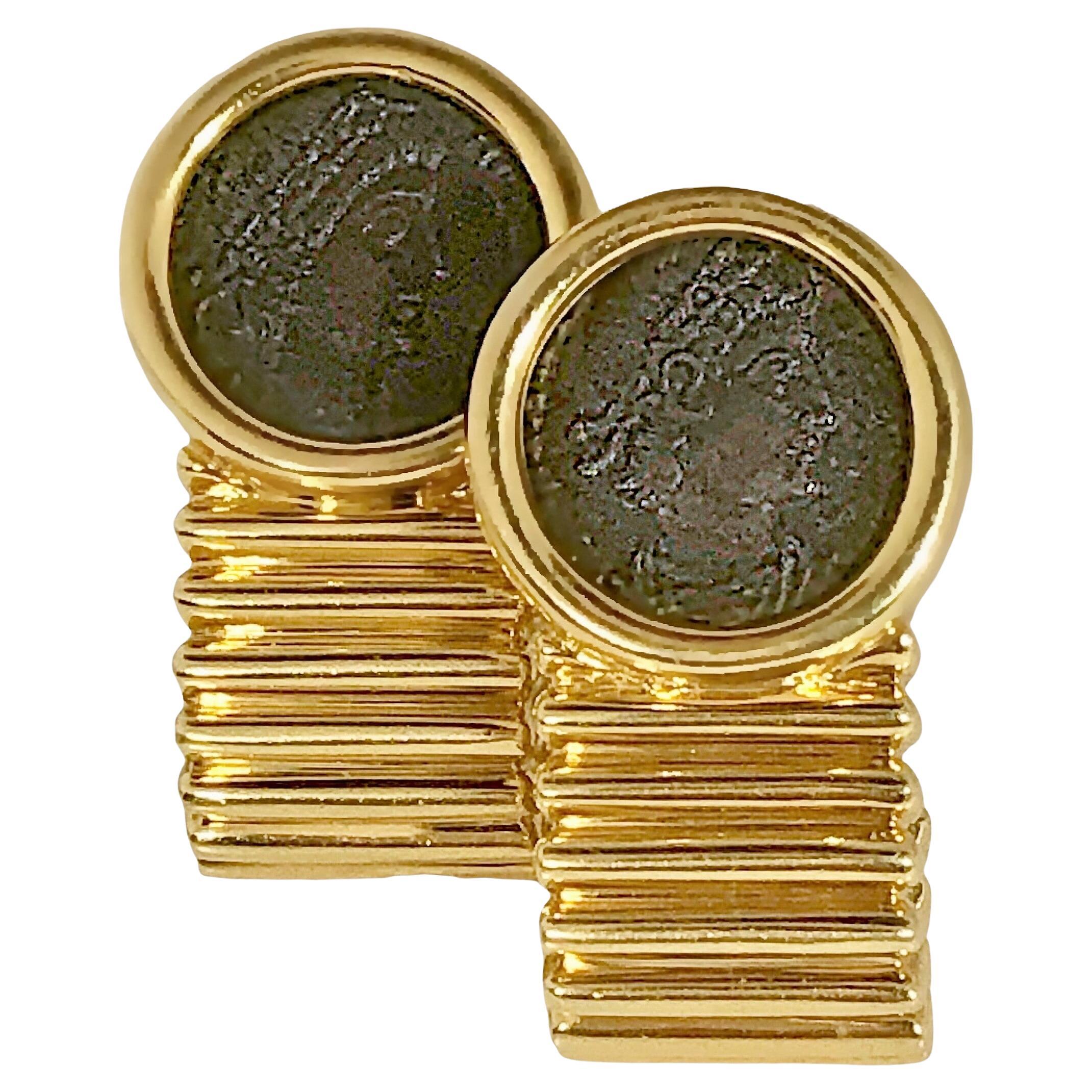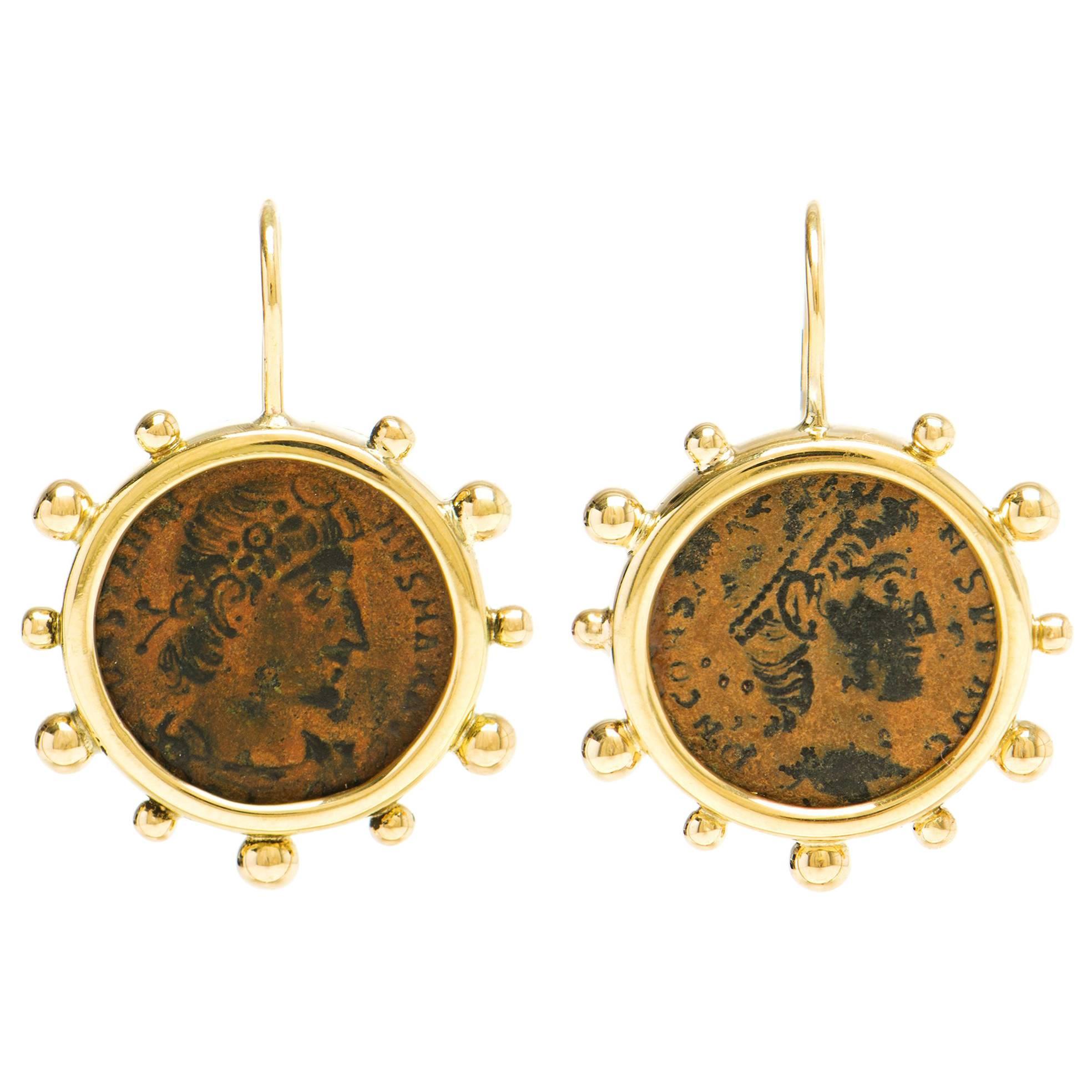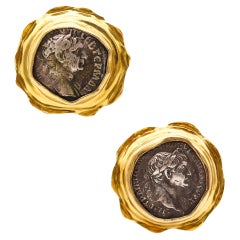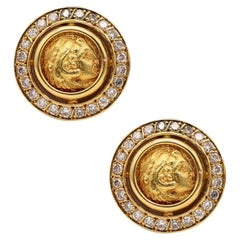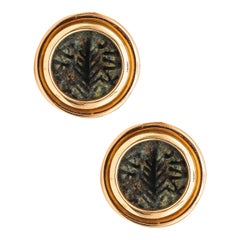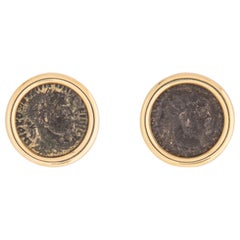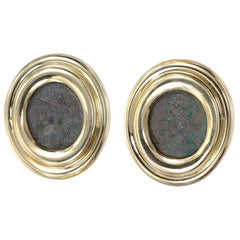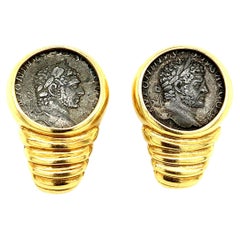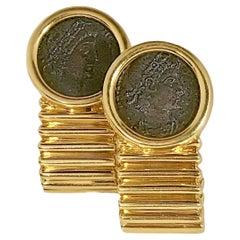Items Similar to ROMAN EMPIRE 290-306 AD Roman Emperors Coins Earrings In 18Kt Yellow Gold
Want more images or videos?
Request additional images or videos from the seller
1 of 11
ROMAN EMPIRE 290-306 AD Roman Emperors Coins Earrings In 18Kt Yellow Gold
$3,988per set
$4,985per set20% Off
£3,044.82per set
£3,806.03per set20% Off
€3,518.26per set
€4,397.83per set20% Off
CA$5,598.40per set
CA$6,998per set20% Off
A$6,240per set
A$7,800per set20% Off
CHF 3,273.91per set
CHF 4,092.39per set20% Off
MX$76,200.53per set
MX$95,250.67per set20% Off
NOK 41,454.85per set
NOK 51,818.56per set20% Off
SEK 39,181.14per set
SEK 48,976.42per set20% Off
DKK 26,258.33per set
DKK 32,822.91per set20% Off
About the Item
Pair of earrings with Ancient Romans Coins.
This is a beautiful pair of clips-on earrings with genuine ancient Romans coins. The earrings were crafted in Italy in solid yellow gold of 18 karats with high polished finish. They were made up in a round shape and professionally mounted with two genuine ancient Romans coins. They are fitted at the reverse with gold posts for pierced ears and a pair of comfortable hinged French omega backs for fastening clips. The coins mounted in this pair are beautiful authentic ancient Roman coins struck during the Roman Imperial period between 27 BC and 476 AD.
First coin, Follie struck in Treveri Mint, 306 to 337 AD
Obverse description: The laureate young portrait bust of the Emperor Constantine 306 to 337 AD, facing to the right, with the legend around, IMP CONSTANTINVS P F AVG.
Reverse description: The standing figure of the Emperor to the right, holding small figure of Victoria in the right hand. Legend around SOLI INVICTO COMITI/ T-F/ PTR.
Second Coin, Antonianus Struck in Antioch Mint, 293-295 AD
Obverse description: The crowned, bearded and cuirassed portrait bust of the Emperor Diocletian 284-305 AD, facing to the right with legend in Latin around, IMP C C VAL DIOCLETIANVS P F AVG.
Reverse description: The emperor standing right, holding sceptre and receiving Victory from Jupiter standing left, holding sceptre; Legend around: Z/ CONCORDIA MILI-TVM,
Catalogue number: RIC V 322.
The Emperor Constantine
He was born as Flavius Valerius Constantinus in 27 February c. 272 also known as Constantine the Great, was the Roman emperor from AD 306 to 337, the first one to convert to Christianity. Born in Naissus, Dacia Mediterranea, now Serbia. He was the son of Flavius Constantius, a Roman army officer of Illyrian origin who had been one of the four rulers of the Tetrarchy. His mother, Helena, was a Greek Christian of low birth. Later canonized as a saint, she is traditionally attributed with the conversion of her son. Constantine served with distinction under the Roman emperors Diocletian and Galerius. He began his career by campaigning in the eastern provinces (against the Persians) before being recalled in the west (in AD 305) to fight alongside his father in Britain. After his father's death in 306, Constantine became emperor. He was acclaimed by his army at Eboracum in York, England, and eventually emerged victorious in the civil wars against emperors Maxentius and Licinius to become the sole ruler of the Roman Empire by 324 AD.
The Emperor Diocletian
Diocletian was Roman emperor from 284 until his abdication in 305. He was born Diocles to a family of low status in the Roman province of Dalmatia. Diocles rose through the ranks of the military early in his career, eventually becoming a cavalry commander for the army of Emperor Carus. After the deaths of Carus and his son Numerian on a campaign in Persia, Diocles was proclaimed emperor by the troops, taking the name Diocletianus. The title was also claimed by Carus's surviving son, Carinus, but Diocletian defeated him in the Battle of the Margus. Diocletian's reign stabilized the empire and ended the Crisis of the Third Century. He appointed fellow officer Maximian as Augustus, co-emperor, in 286. Diocletian reigned in the Eastern Empire, and Maximian reigned in the Western Empire. Diocletian delegated further on 1 March 293, appointing Galerius and Constantius as junior colleagues (each with the title Caesar), under himself and Maximian respectively. Under the Tetrarchy, or "rule of four", each tetrarch would rule over a quarter-division of the empire. Diocletian secured the empire's borders and purged it of all threats to his power. He defeated the Sarmatians and Carpi during several campaigns between 285 and 299, the Alamanni in 288, and usurpers in Egypt between 297 and 298. Galerius, aided by Diocletian, campaigned successfully against Persia, the empire's traditional enemy, and in 299, he sacked their capital, Ctesiphon. Diocletian led the subsequent negotiations and achieved a lasting and favorable peace.
Weight: Both combined are 26.45 grams (17.10 Dwt.).
Measurements: Each diameters of 29 mm (1.14 Inches).
Hallmarks: They are both stamped with the maker's mark M for Michaels and the mark for the assay of the 18kt gold, as follow; "M .750".
Numismatic Literature: The Roman Republic Coinage, Michael Hewson Crawford, Cambridge University Press, 1974.
Note: Both coins are guarantee to be genuine and authentic from the stated period of the Roman Empire. The strike is perfect, in high relief, well detailed and with an exceptional chocolate patina. They are virtually in near mint condition and fresh as struck. Very rare in this rare grade of preservation.
Collateral: These earrings are accompanied by a presentation jewelry box.
Condition: The overall condition of these earrings are excellent. Beside the little normal wear, there is no damage to the gold. The 2 Roman coins are secured in their settings. This pair has been carefully inspected to guarantee the condition and authenticity.
INVENTORY REF: E091024MRNS/.6358
- Creator:Roman Empire Coin Earrings
- Metal:
- Weight:26.45 g
- Dimensions:Depth: 0.25 in (6.35 mm)Diameter: 1.14 in (28.96 mm)
- Sold As:Set of 2
- Style:
- Place of Origin:
- Period:15th Century and Earlier
- Date of Manufacture:290-306 AD
- Condition:Wear consistent with age and use. The overall condition of these earrings are excellent. Beside the little normal wear, there is no damage to the gold. The 2 Roman coins are secured in their settings. This pair has been carefully inspected to guarantee the condition and authenticity.
- Seller Location:Miami, FL
- Reference Number:Seller: E091024MRNS/.63581stDibs: LU2690224217762
About the Seller
5.0
Recognized Seller
These prestigious sellers are industry leaders and represent the highest echelon for item quality and design.
Platinum Seller
Premium sellers with a 4.7+ rating and 24-hour response times
Established in 1995
1stDibs seller since 2022
918 sales on 1stDibs
Typical response time: <1 hour
- ShippingRetrieving quote...Shipping from: Miami, FL
- Return Policy
Authenticity Guarantee
In the unlikely event there’s an issue with an item’s authenticity, contact us within 1 year for a full refund. DetailsMoney-Back Guarantee
If your item is not as described, is damaged in transit, or does not arrive, contact us within 7 days for a full refund. Details24-Hour Cancellation
You have a 24-hour grace period in which to reconsider your purchase, with no questions asked.Vetted Professional Sellers
Our world-class sellers must adhere to strict standards for service and quality, maintaining the integrity of our listings.Price-Match Guarantee
If you find that a seller listed the same item for a lower price elsewhere, we’ll match it.Trusted Global Delivery
Our best-in-class carrier network provides specialized shipping options worldwide, including custom delivery.More From This Seller
View AllANCIENT ROME 98-117 AD Denarius Coins Clips-On Earrings In 18Kt Yellow Gold
Located in Miami, FL
Pair of earrings with Ancient Roman Empire coins.
This is a stunning pair of clips-on earrings mounted with two genuine ancient silver denarius coins from the Roman Empire. The earr...
Category
Vintage 1980s Italian Classical Roman Clip-on Earrings
Materials
Gold, Yellow Gold, Silver, 18k Gold
$3,988 Sale Price / set
20% Off
Free Shipping
BVLGARI Roma 1970 Moneta 268 BC Roman Coins Earrings In 18Kt Yellow Gold
By Bulgari
Located in Miami, FL
A Moneta earrings designed by Bvlgari.
This pair of earrings are from the iconic Moneta collection created by Bvlgari, back in the late 1970's. The rare earrings has been crafted in...
Category
Vintage 1970s Italian Classical Greek Clip-on Earrings
Materials
Gold, Yellow Gold, Silver, 18k Gold
Ancient Greek 359 BC Classic Gold Coin Earrings 18Kt Gold with 2.42 Cts Diamonds
Located in Miami, FL
Clips-earrings with ancient gold coins from Phillip II of Macedon.
A classic pair of earrings, mounted with two authentic ancient Greek gold coins...
Category
Vintage 1980s American Etruscan Revival Clip-on Earrings
Materials
Diamond, White Diamond, Gold, 18k Gold, 22k Gold, Yellow Gold
$7,160 Sale Price / set
20% Off
Free Shipping
Ancient Rome Judaea 58 AD Bronze Prutah Coins Cufflinks in 14Kt Yellow Gold
Located in Miami, FL
Cufflinks with ancient Roman coins from Judaea.
Great pair of rare ancient Judean (Jerusalem) coins minted during the period of the Roman Empire administration. These bronze coins were called Prutah and were minted in the city of Jerusalem around 58-59 AD. Cradled in the name of the Roman procurator Porcio Festo (59-62 AD) under the rule of Emperor Nero (54-68 AD).
These genuine coins was carefully mounted in an elaborated cufflinks with double frames crafted in solid yellow gold of 14 karats with polished finish and fitted with movable hinged pressured T-bars for comfort fit.
Obverse: Greek letters KAICAPOC (Caesar) and date LЄ (year 5=58/59 A.D), palm branch.
Reverse: Greek letters NЄP WNO C (Nero) in wreath tied at the bottom with an X.
Mint: Roman mint at Jerusalem.
Numismatic Literature: Hendin-1351 (5th Edition); Hendin-653 (3rd Edition).
Weight: Total of 17.8 Grams, (11.41 Dwt). Coins are approximate 2.45 Grams each.
Measurements: 21.6 mm by 21.6 mm (0.85 x 0.85 Inches).
Hallmarks: Stamped with the maker's mark and the 14kt gold assay mark.
Porcius Festus was procurator of Judea from about AD 58 to 62, succeeding Antonius Felix. His exact time in office is not known. He inherited all of the problems of his predecessor in regard to the Roman practice of creating civic privileges for Jews. Only one other issue bedeviled his administration, the controversy between Agrippa II and the priests in Jerusalem regarding the wall erected at the temple to break the view of the new wing of Agrippa's palace.
During his administration, Jewish hostility to Rome was greatly inflamed by the civic privileges issue. Feelings were aroused which played an important part in the closely following Jewish War of AD 66.
In the New Testament, the Apostle Paul had his final hearing before Festus. In Acts 25:12, Festus sought to induce Paul to go to Jerusalem for trial; Paul appealed to the Emperor. the appeal resulted in Paul being deported to Rome in the autumn of AD 58. Acts 25-26.
Nero (Latin: Nero Claudius Caesar Augustus Germanicus;15 December 37 - 9 June 68) was Roman Emperor from 54 to 68, and the last in the Julio-Claudian dynasty. Nero was adopted by his great uncle Claudius to become his heir and successor, and succeeded to the throne in 54 following Claudius' death. During his reign, Nero focused much of his attention on diplomacy, trade, and enhancing the cultural life of the Empire. He ordered theaters built and promoted athletic games. During his reign, the redoubtable general Corbulo conducted a successful war and negotiated peace with the Parthian Empire. His general Suetonius Paulinus crushed a revolt in Britain. Nero annexed the Bosporan Kingdom to the Empire and began the First Roman-Jewish War.
In 64, most of Rome was destroyed in the Great Fire of Rome, which many Romans believed Nero himself had started in order to clear land for his planned palatial complex, the Domus Aurea. In 68, the rebellion of Vindex in Gaul and later the acclamation of Galba in Hispania drove Nero from the throne. Facing assassination, he committed suicide on 9 June 68 (the first Roman emperor to do so) His death ended the Julio-Claudian Dynasty, sparking a brief period of civil wars known as the Year of the Four Emperors. Nero's rule is often associated with tyranny and extravagance. He is known for many executions, including that of his mother, and the probable murder by poison of his stepbrother Britannicus.
He is infamously known as the Emperor who "fiddled while Rome burned" and as an early persecutor of Christians. He was known for having captured Christians to burn them in his garden at night for a source of light. This view is based on the writings of Tacitus, Suetonius, and Cassius Dio, the main surviving sources for Nero's reign. Few surviving sources paint Nero in a favorable light. Some sources, though, including some mentioned above, portray him as an emperor who was popular with the common Roman people, especially in the East. Some modern historians question the reliability of ancient sources when reporting on Nero's tyrannical acts.
Prutah (Hebrew: פרוטה) is a word borrowed from the Mishnah and the Talmud, in which it means "a coin of smaller value". The word was probably derived originally from an Aramaic word with the same meaning. The prutah was an ancient copper Jewish coin...
Category
Late 20th Century Italian Classical Roman Cufflinks
Materials
14k Gold, Yellow Gold, Bronze
$1,880 Sale Price
20% Off
Free Shipping
Victorian 1860 Etruscan Revival Earrings 18Kt Gold with Carved Agates Intaglios
Located in Miami, FL
Exceptional Victorian Etruscan Revival earrings.
Very rare and highly decorated hexagonal pieces, created in England during the Victorian Era (1837-1901), circa 1850-1860 or earlier...
Category
Antique 1860s English Etruscan Revival Clip-on Earrings
Materials
Agate, Gold, 18k Gold, Yellow Gold
$6,840 Sale Price
20% Off
Free Shipping
ROMAN EMPIRE 300 AD Emperor Constantine Coin Pendant In 18Kt Gold And Sapphires
Located in Miami, FL
An ancient Roman coin pendant designed by Fratelli Terziani.
This is an elegant pendant displaying an ancient Roman coin created in the city of Arezzo Italy at the goldsmith’s ateli...
Category
Vintage 1970s Italian Classical Roman Pendant Necklaces
Materials
Sapphire, Blue Sapphire, Gold, Yellow Gold, Bronze, 18k Gold
You May Also Like
Classic Ancient Coin and Gold Bezel Earring
Located in Atlanta, GA
A style that iconic Italian jeweler Bvlgari made popular. A pair of ancient coins are framed with heavy 18k bezels to create a wearable chic style. 7/8's of an inch in size.
Category
Late 20th Century American Contemporary Clip-on Earrings
Materials
18k Gold
Yellow Gold Ancient Coin Clip Post Earrings
Located in Stamford, CT
Oval clip post 14k yellow gold clip post earrings set with a matched pair of ancient coins.
14k yellow gold
Stamped: 14k
Top to bottom: 28.65mm o...
Category
Late 20th Century Lever-Back Earrings
Materials
Gold, 14k Gold, Yellow Gold
Yellow Gold Ancient Roman Coin Ear Clips
Located in New York, NY
A pair of 18 karat yellow gold ear clips with a replica of Roman coins at their center. Total weight: 24.2 grams. Width: 1.8 cm. Length: 2.6 cm.
Category
Vintage 1980s Classical Roman Clip-on Earrings
Materials
18k Gold, Yellow Gold
18K Yellow Gold Tubogas Style Earrings with Ancient Coins
Located in Palm Beach, FL
These lovely vintage 18K yellow gold tubogas style earrings are topped with two authentic ancient bronze coins depicting Constantinus the Great from 324AD. Below the bezel set coins ...
Category
Late 20th Century Modern Lever-Back Earrings
Materials
18k Gold, Yellow Gold
Dubini Constantine Roman Ancient Bronze Coin 18K Yellow Gold Earrings
By DUBINI
Located in London, GB
These Dubini coin earrings from the 'Empires' collection feature authentic Roman Imperial bronze coins set in 18K yellow gold.
Coin Ø 15-18mm
ABOUT THE COINS
Patina is that beauti...
Category
21st Century and Contemporary Italian Classical Roman Drop Earrings
Materials
18k Gold, Yellow Gold, Bronze
Ancient Roman Coins 18K Yellow Gold Clip-on Earrings
Located in Miami, FL
A pair of clip-on earrings circa 1960-70 featuring ancient Roman coins. The setting is made in 18-karat yellow gold adorned with small cabochon sapphire and ruby on the lower side of...
Category
Vintage 1960s Unknown Contemporary Clip-on Earrings
Materials
Ruby, Blue Sapphire, Yellow Gold
More Ways To Browse
Roman Coin Jewelry
Roman Gold Coin
Ancient Roman Coins
Gold Coin French
Rare Gold Coin
18k And Ancient Roman Coin
French Coin Jewelry
Ancient Greek Earrings
Ancient Roman Earrings
Egyptian Gold Earrings
Roman Emperor Bust
Antique Roman Coin
Persian Yellow Gold Jewelry
Gold Coin Mounting
Ancient Coin Earrings
French Cavalry
Antique Civil War Jewelry
Roman Coin Bc
